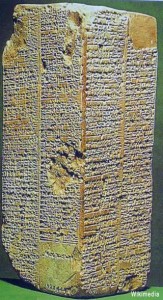
 |
| Who were these god-kings? |
Out of the many incredible artifacts that have been recovered from sites in Iraq [formerly Mesopotamia, Babylon, "Western Asia"] where flourishing Sumerian cities once stood, few have been more intriguing that the Sumerian King List.
This list is an ancient manuscript originally recorded in the Sumerian language that lists the kings of Sumer (ancient Southern Iraq) from Sumerian and neighboring dynasties, their supposed reign lengths, and the locations of “official” kingship.
What makes this artifact so original is the fact that the list blends apparently mythical pre-dynastic rulers with historical rulers who are known to have existed.
The first fragment of this rare and unique text -- a 4,000-year-old cuneiform tablet -- was found in the early 1900s by German-American scholar Hermann Hilprecht at the site of ancient Nippur and published in 1906.
Since Hilprecht’s discovery at least 18 other exemplars of the king’s list have been found, most of them dating from the second half of the Isin Dynasty (circa 2017-1794 BCE).
No two of these documents are identical. However, there is enough common material in all versions of the list to make it clear that they are derived from a single, “ideal” account of Sumerian history.

This list is an ancient manuscript originally recorded in the Sumerian language that lists the kings of Sumer (ancient Southern Iraq) from Sumerian and neighboring dynasties, their supposed reign lengths, and the locations of “official” kingship.
 |
| Were the Annunaki (Asuras, Titans) giants? |
The first fragment of this rare and unique text -- a 4,000-year-old cuneiform tablet -- was found in the early 1900s by German-American scholar Hermann Hilprecht at the site of ancient Nippur and published in 1906.
Since Hilprecht’s discovery at least 18 other exemplars of the king’s list have been found, most of them dating from the second half of the Isin Dynasty (circa 2017-1794 BCE).
No two of these documents are identical. However, there is enough common material in all versions of the list to make it clear that they are derived from a single, “ideal” account of Sumerian history.

 Among all the examples of the Sumerian King List, the Weld-Blundell prism (shown at right) in the Ashmolean Museum cuneiform collection in Oxford, represents the most extensive version as well as the most complete copy of the King List.
Among all the examples of the Sumerian King List, the Weld-Blundell prism (shown at right) in the Ashmolean Museum cuneiform collection in Oxford, represents the most extensive version as well as the most complete copy of the King List. The 8-inch-high prism contains four sides with two columns on each side. It is believed that it originally had a wooden spindle going through its center so that it could be rotated and read on all four sides.
It lists rulers from the antediluvian (“before the flood”) dynasties to the fourteenth ruler of the Isin Dynasty (circa 1763-1753 BCE).
The list is of immense value because it reflects very old traditions while at the same time providing an important chronological framework relating to the different periods of kingship in Sumeria. It also demonstrates remarkable parallels to accounts in Genesis [of the Judeo-Christian Bible].
The ancient civilization of Sumer

Sumer (sometimes called Sumeria), is the site of the earliest known civilization.
It is/was located in the southernmost part of Mesopotamia between the Tigris and the Euphrates rivers, in the area that later became Babylonia and is now southern Iraq from around Baghdad to the Persian Gulf.
By the third millennium BCE, Sumer was the site of at least 12 separate city states:
- Kish
- Erech
- Ur
- Sippar
- Akshak
- Larak
- Nippur
- Adab
- Umma
- Lagash
- Bad-tibira
- Larsa.
The Sumerian King List records that eight kings reigned before a great flood. After the Flood various city-states and their dynasties of kings temporarily gained power over the others.
Sumer’s mythical past
 |
| Cuneiform Sumerian clay tablet writing |
The Sumerian King List begins with the very origin of kingship, which is seen as a divine institution: “the kingship had descended from heaven.” The rulers in the earliest dynasties are represented as reigning fantastically long periods:
“After the kingship descended from heaven, the kingship was in Eridug. In Eridug, Alulim became king; he ruled for 28,800 years. Alaljar ruled for 36,000 years. Two kings; they ruled for 64,800 years.”
Some of the rulers mentioned in the early list -- such as Etana, Lugal-banda, and Gilgamesh -- are mythical or legendary figures whose heroic feats are subjects of a series of Sumerian and Babylonian narrative compositions.... More
Zecharia Sitchin
 Sitchin (July 11, 1920-October 9, 2010) was an Azerbaijani-born American author of books proposing an explanation for human origins involving ancient astronauts based on his translation of the Sumerian tablets.
Sitchin (July 11, 1920-October 9, 2010) was an Azerbaijani-born American author of books proposing an explanation for human origins involving ancient astronauts based on his translation of the Sumerian tablets.
He proposed many controversial translations, interpretations, and theories -- all, he said, based on the texts themselves. Some say he read more into them than was there, or they could not read and understand what he did.
Free downloadable e-books
The below e-books are free to download and can be accessed in our e-book library under Ancient Wisdom. A free membership to access the e-book library is required.

References
- The Sumerian King List – University of Oxford
- Great Discoveries in Biblical Archaeology: The Sumerian King List – by Bryant G. Wood
- The Sumerian king list: translation – The Electronic Text Corpus of Sumerian Literature
- The Sumerian King List – by L.C.Geerts
- Reinvestigating the Antediluvian Sumerian King List – by R. K. Harrison
- The Sumerian King List – by Thorkild Jacobsen (The Oriental Institute of the University of California)






















































































































































































































































No comments:
Post a Comment